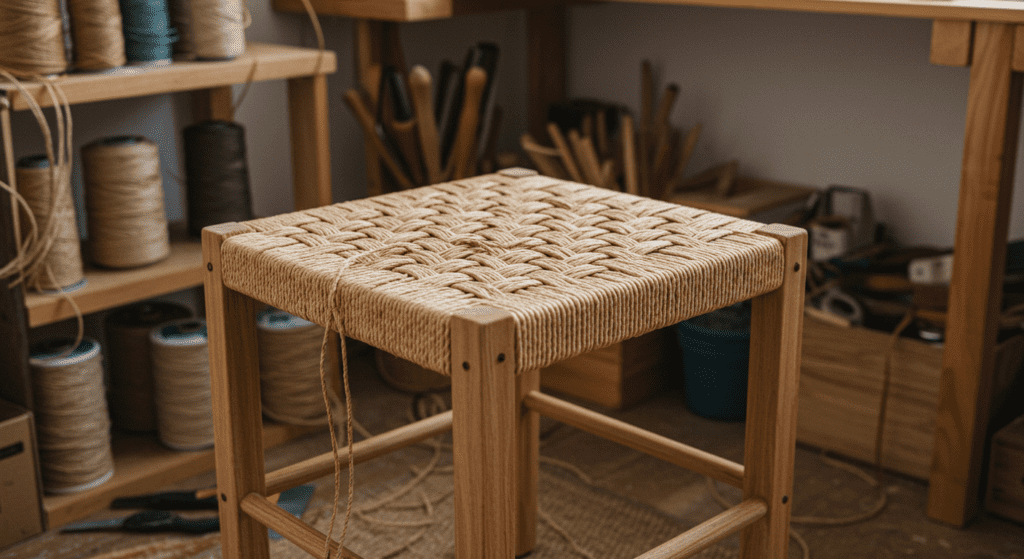1- Introduction
A woven stool is a beautiful and functional piece of furniture that can add a touch of rustic charm to any home. Whether you’re a seasoned DIY enthusiast or a beginner looking for a new project, crafting a woven stool can be a rewarding experience. This guide will walk you through the process of making a woven stool, from gathering materials to the final touches.

2- Content
Materials Needed
- Wooden Frame: You can either build your own frame or purchase a pre-made one.
- Rattan or Cane: For the weaving material.
- Scissors or a Sharp Knife: For cutting the rattan or cane.
- Staple Gun: For securing the weaving material to the frame.
- Sandpaper: For smoothing any rough edges.
- Wood Glue: For securing joints if you’re building your own frame.
- Paint or Stain: Optional, for finishing the frame.
Step-by-Step Instructions
- Prepare the Frame
- If you’re building your own frame, cut the wood pieces to the desired size and shape. Use wood glue and clamps to secure the joints. Allow the glue to dry completely.
- If you’re using a pre-made frame, ensure it is sturdy and free of any defects.
- Sand the Frame
- Use sandpaper to smooth any rough edges or surfaces on the frame. This will make the weaving process easier and ensure a polished final product.
- Paint or Stain the Frame
- If desired, apply paint or stain to the frame and allow it to dry completely. This step is optional but can add a personalized touch to your stool.
- Prepare the Weaving Material
- Cut the rattan or cane into strips of the appropriate length. The length will depend on the size of your frame and the desired pattern.
- Begin Weaving
- Start by securing one end of the rattan or cane to the frame using a staple gun. Begin weaving the material around the frame, following your chosen pattern.
- For a simple pattern, weave the material over and under the frame in a crisscross pattern. For more intricate designs, you can experiment with different weaving techniques.
- Secure the Weaving
- As you weave, periodically secure the material to the frame using the staple gun. This will help keep the weaving tight and prevent it from shifting.
- Finish the Weaving
- Once you’ve completed the weaving, secure the final end of the rattan or cane to the frame. Trim any excess material with scissors or a sharp knife.
- Final Touches
- Inspect the stool for any loose ends or rough spots. Use the staple gun to secure any loose ends and sandpaper to smooth any rough spots.
3- Conclusion
Crafting a woven stool is a satisfying project that combines creativity with practical skills. Whether you choose a simple or intricate weaving pattern, the result is a unique and functional piece of furniture that you can be proud of. With a bit of patience and attention to detail, you can create a beautiful woven stool that will be a cherished addition to your home.
FAQ
- What type of wood is best for the frame?
- Hardwoods like oak, maple, or cherry are durable and suitable for the frame. Softwoods like pine can also be used but may not be as sturdy.
- Can I use synthetic materials for weaving?
- Yes, synthetic materials like plastic or nylon can be used for weaving. They are often more durable and easier to clean than natural materials.
- How do I choose a weaving pattern?
- Start with a simple pattern if you’re new to weaving. As you gain experience, you can experiment with more complex designs. There are many resources available online for different weaving patterns.
- What if I make a mistake while weaving?
- Mistakes are a natural part of the learning process. If you make a mistake, simply unweave the affected section and start again. With practice, you’ll become more proficient.
- How do I maintain my woven stool?
- Regularly dust your stool and avoid exposing it to direct sunlight or moisture. If the weaving becomes loose over time, you can re-secure it with a staple gun.